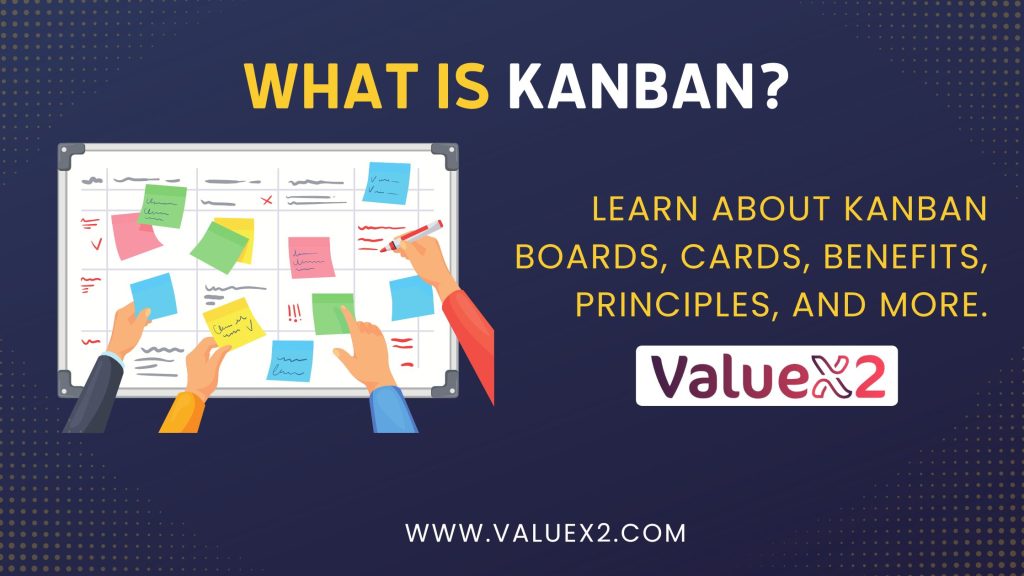Here’s all you need to know about Kanban. Learn about Kanban boards, cards, benefits, principles, and more.

Are you taking a step into the future and going agile? This is what is happening worldwide in almost all organizations. Agility has changed the process of delivering products and services for the better. Kanban, among the topmost recognized frameworks, is an easy and effective way to manage work and improve your team’s processes.
Kanban originated from Toyota’s manufacturing system in the 1940s. It is an Agile methodology that uses visual tools to illustrate the progress reached in a project or task, thus smoothening the workflow. With Kanban, you avoid overwhelming your team as it tends to pull work from a backlog maintaining everything as it is.
How Does Kanban Work?
From the introduction, you can say you already have a glimpse of how Kanban works. Let us explain further. It is all about visualizing work using a Kanban board. Try imagining a large board with many columns dividing it, each representing a stage of your workflow. For example;
- “To Do”
- “In Progress”
- “Done”
The tasks to be completed are written on cards which are then passed up to these columns as they progress. By so doing, every member of the team gets to know what is going on at a glance.
Why Use Kanban?
So, why Kanban? Reviews have it that it helps teams become more flexible and efficient. In software development, Kanban is heavily used, but this does not mean that other projects are limited to it. Kanban does not criticize projects. By limiting the amount of work in progress, teams can focus better and avoid bottlenecks. This leads to higher quality work and faster delivery times.
Virtual Kanban Boards
In this current digital era, many organizations use online tools to come up with virtual Kanban boards. Real-time progress tracking, remote collaboration, and task updates are all made simple by these technologies. The ability to view and easily manage your workflow now with the help of platforms like Asana, Trello, and Jira is made possible.
What are Kanban cards?
We can agree that Kanban cards mark the heart of Kanban systems. They represent individual tasks or work items, and each card holds information on the task to be accomplished. It contains the title of the task, description, date due and the ones responsible for the task. Think of this like sticky notes on a board.
By using different colour codes, teams can come up with a key to understand the priority of different tasks. Isn’t this making work easier? For instance, a red card might indicate a high-priority task, while a green card can signify a routine task. This is the visual aspect of Kanban cards, that make teams stay more organized and focused on what the next move should be.
Key Principles of Kanban
- Visualize Your Work: To view every work and its stage in clear sight, use Kanban.
- Limit Work in Progress (WIP): To avoid overload, place restrictions on the number of jobs that can be ongoing at once.
- Control Flow: Ensure that activities proceed without hiccups throughout.
- Make Policies Explicit: Clearly identify and explain your process rules.
- Create Feedback Loops: Review and adjust your workflow on a regular basis in response to input.
- Work Together to Improve, Try New Things to Evolve: Motivate team members to offer suggestions and make changes.
Benefits of Kanban
The Kanban board has many benefits to it, we at ValueX2.com, have collected several advantages for you.
- Real-time visibility: Allows everyone to be aware of what is going on and who is in charge of what.
- Flexibility: Change priorities and tasks without worrying about meeting deadlines.
- Enhanced Efficiency: Teams can operate more effectively and provide greater outcomes by concentrating on fewer activities at once.
- Continuous Improvement: Teams improve over time when they regularly assess their processes.
Potential Downside
Kanban is a good methodology to implement for your firm and organizations. Although it is perfect, it is not good for all situations. All that glitters is not gold, it might be silver or even bronze. Such situations are like:
1. Overwhelming for the large teams
An organization having teams with large numbers might feel this downside. If they face too many tasks, it can clutter the board and become hard to manage. Picture a board with hundreds of cards, each representing a different task. Keeping track of every single one of these tasks can become chaotic.
For large teams, automatically, breaking down work into easily manageable sections is the go-to if you are trying to make work easier. You can also try using multiple Kanban boards for different projects or sub-teams to maintain clarity and organization.
2. Not well-known Outside Engineering
Having originated from the manufacturing world and finding a strong foot in the land of software development, this means it is not familiar with other industries. Non-engineering teams might find it a bit challenging to adapt to the Kanban system at the beginning. They might need more time and training to understand how it works and how best to implement it.
Marketing and HR teams might be more accustomed to traditional project management methods, but with the right guidance and support, they can move more towards a Kanban approach. Therefore, with gradual implementation and proper training, you can transform your whole organization to get comfortable with Kanban and leverage its benefits.
How to get started with Kanban
Have you come to the decision where you want to be associated with Kanban? Worry not, ValueX2 provides you with a step-by-step procedure on how you can create a Kanban board.
- Start with a blank board: Take a blank board, and set up columns on it that represent your workflow stages.
- Add tasks as Cards: Write down the tasks to be covered on each card, one card one task. Place every card in its appropriate column.
- Move tasks through columns: As work progresses throughout the projects, move the cards from left to right until competition.
- Review and improve: Regularly check your board and adjust where needed to ensure that things are carried out smoothly.
Wrap-Up
As Kanban is a powerful tool, it has the capability to help any team manage work more effectively. We have seen that Kanban visualizes tasks, limits work in progress and continuously improves processes. By doing so, it helps teams stay organized and productive. There is no downside to using either a physical tool or an online tool, the Kanban principles can make a big difference in how your team works.

Bhavna is an Agile Coach and Consultant with over a decade of experience in advisory, corporate finance, IT assurance, and operations at Big 4 and within the industry in the UK and India. She has recently been the CEO of a start-up where she implemented agile practices within HR, Marketing, and Product teams.
She is also a SAFe® Practice Consultant (SPC) and authorized instructor for ICAgile Agility in HR (ICP-AHR), Agility in Marketing (ICP-MKG), and Business Agility Foundations (ICP – BAF) training courses. She provides training for agile transformation to corporate, public, and private batches, as well as consulting for enterprise agile transformation.






